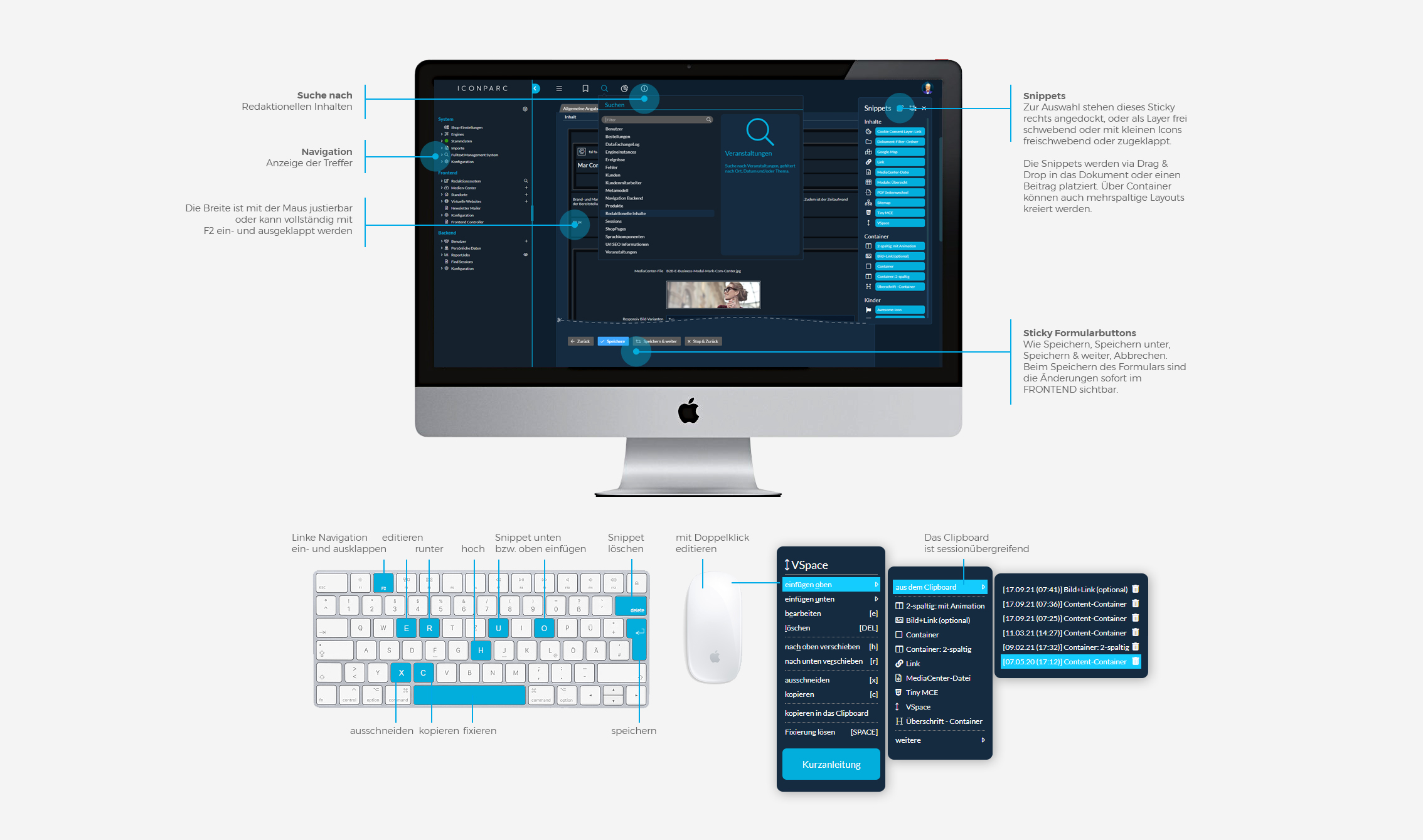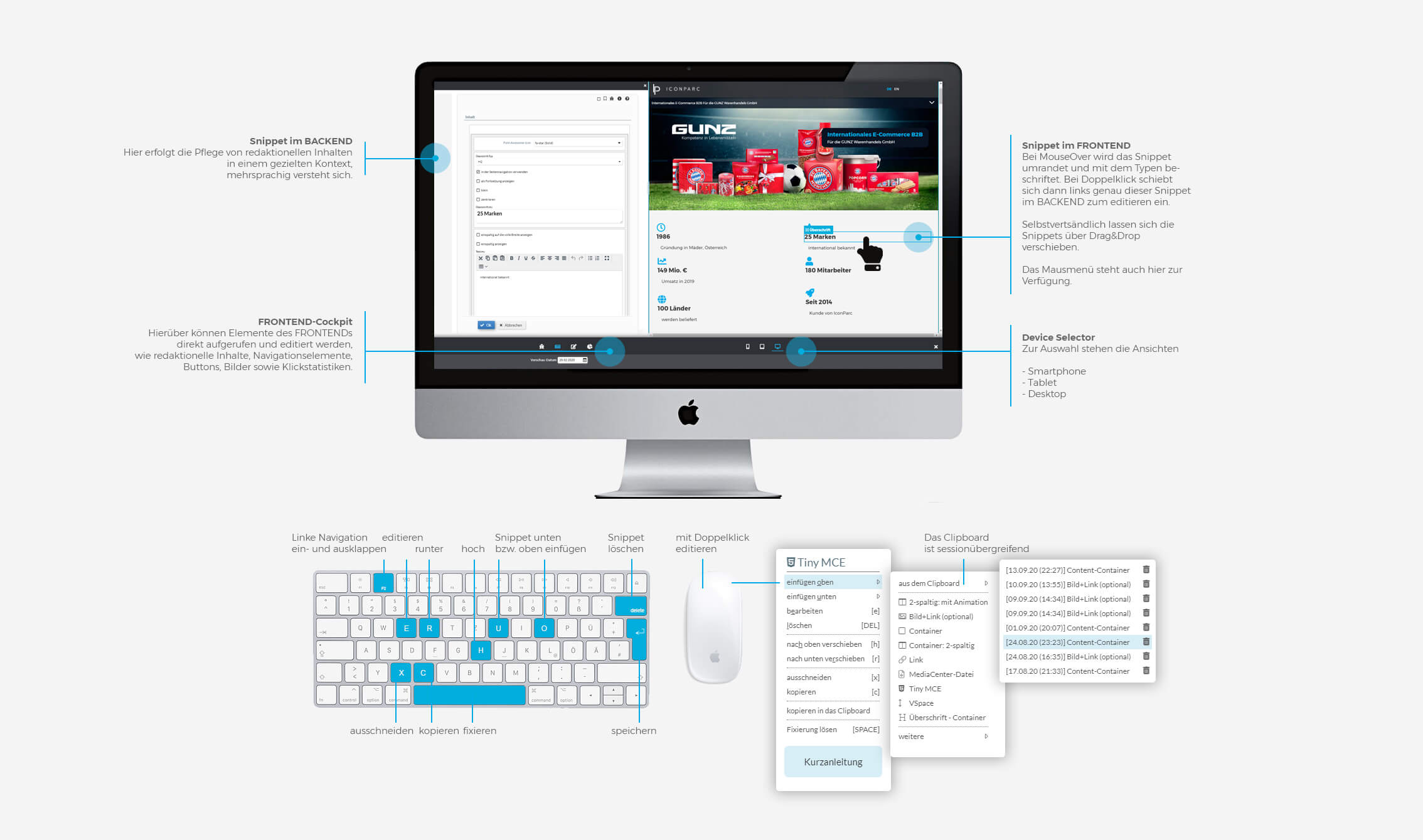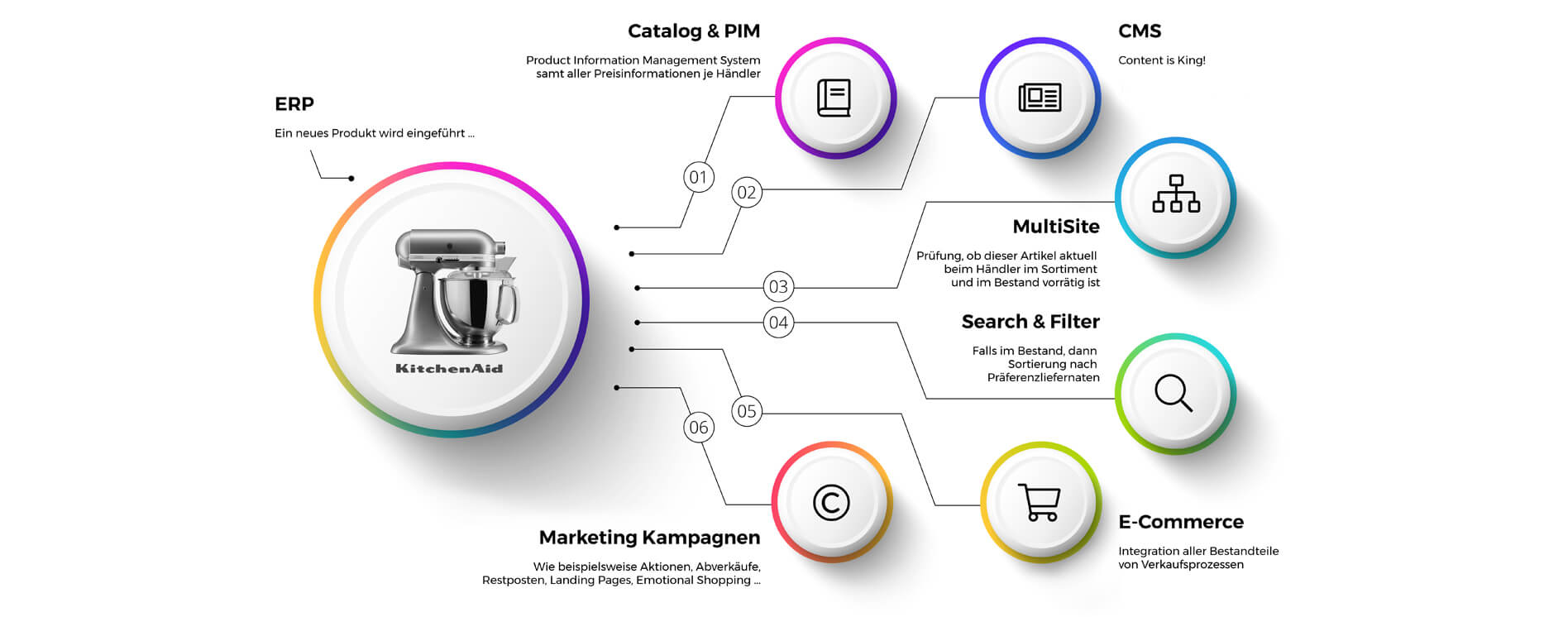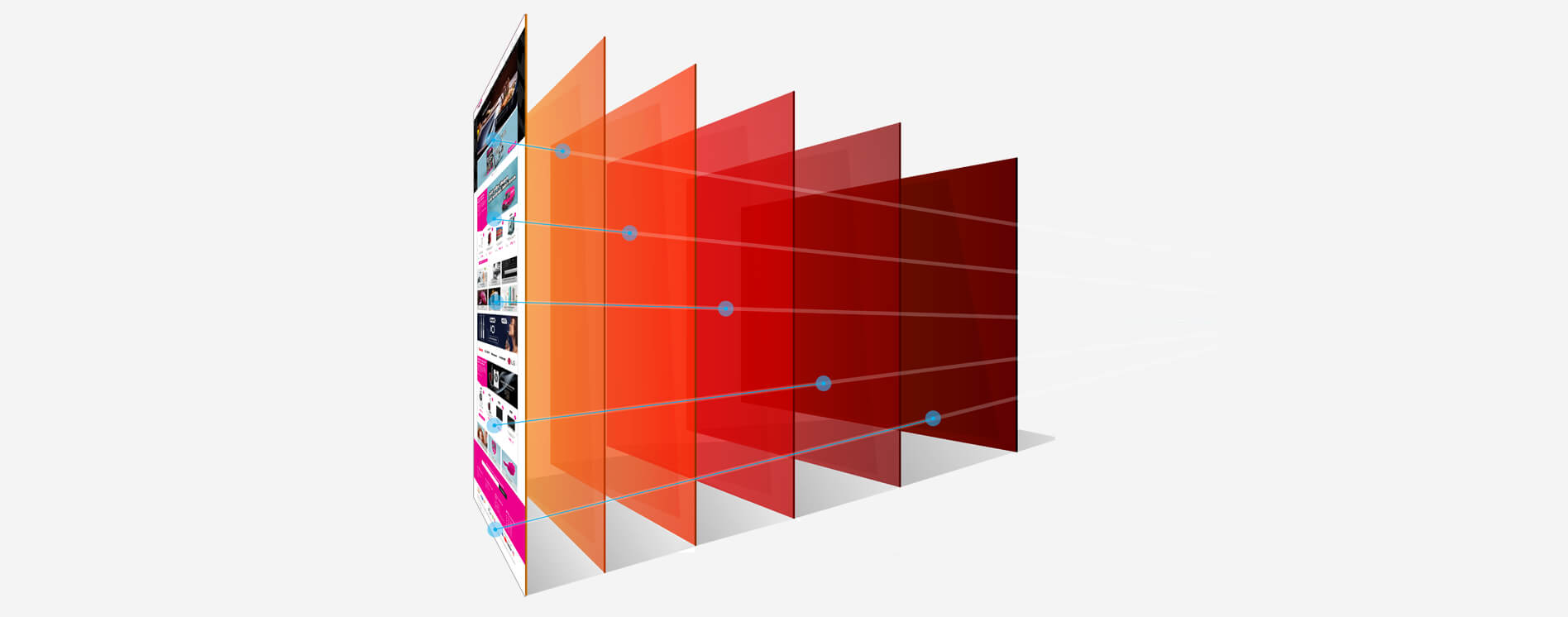CMS
Der erfolgreichste Weg, Besucher immer wieder für Ihren E-Business Auftritt zu begeistern, besteht darin, die FRONTEND Inhalte kontinuierlich zu überarbeiten und zu aktualisieren. Hat Google anfangs noch hauptsächlich Seiten-Metadaten wie Keywords ausgewertet, prüft die Suchmaschine Inhalte inzwischen kontextbasiert auf Sinnhaftigkeit bzw. Themen-spezifische Relevanz. Auf dieser Basis erfolgt dann auch die Einstufung beim Ranking. Darum ist guter Content bei der Neukundengewinnung inzwischen nachhaltiger als teure SEM Maßnahmen.

Mit dem ICONPARC CMS Modul sind Ihnen theoretisch keine Grenzen gesetzt. In der Praxis ist es andererseits unverzichtbar, Strukturen und das Look and Feel bzw. Bediensystematiken durchgängig einheitlich zu gestalten: Diese Herausforderung ist umso größer, je mehr Redakteure zeitgleich, überregional bzw. international verteilt an den Inhalten arbeiten. Dabei ist es wichtig, dass einzelne Redakteure nicht ihre eigenen Design-Vorstellungen zum Ausdruck bringen. Vielmehr sollen Design und allgemein alle gestalterischen Aspekte so umgesetzt sein, wie diese strukturell und visuell vom Brand Management Ihres Unternehmens unter Berücksichtigung der Corporate Identity vorgegeben sind. Sonst laufen Sie Gefahr, dass Ihre Kunden in der Außendarstellung - hier im E-Business FRONTEND - einen kunterbunten Flickenteppich vorfinden, welcher Ihrer Marke keinesfalls gerecht wird.
Die ICONPARC CMS Systematik stellt automatisch und konzeptbedingt die einheitliche Visualisierung aller FRONTEND-Inhalte sicher. Zulässige Freiheitsgrade können fein granular festgelegt werden.
Nachfolgend stellen wir einige Elemente des CMS Moduls vor.
Snippets
Sämtliche redaktionellen Inhalte setzen sich aus einzelnen Content-Schnipseln, den sogenannten Snippets, zusammen. Einfache Snippets können etwa eine Überschrift, ein Bild, ein Video oder einen Textblock repräsentieren. Komplexere Snippets ermöglichen beispielsweise einen „Text-Bild-Link“ Block. Über die zahlreichen, im Standardumfang enthaltenen Snippet-Typen hinaus lassen sich beliebige weitere im Rahmen der Customization definieren.
Vorlagen
Aus der Kombination gewünschter Snippet-Typen entstehen per Konfiguration Vorlagen für die eigentlichen redaktionellen Inhalte, welche sich im Backend der Lösung mithilfe des CMS Vorlagen-Dialog-Assistenten bequem verwalten lassen. Dabei kann beispielsweise festgelegt sein, dass bestimmte Snippet-Typen immer in Inhalten vorhanden sein müssen, welche von einer bestimmten Vorlage abgeleitet werden. Auch die Reihenfolge der anwendbaren Snippet-Typen kann vorgegeben werden, ebenso wie die Zulässigkeit des mehrfachen Auftretens einzelner Snippet-Typen innerhalb der Vorlage.
Beiträge
Im CMS Inhalts-Dialog-Assistenten lassen sich redaktionelle Beiträge erfassen und aktualisieren: Diese Seitenbestandteile können - bei Bedarf personalisiert - an beliebig vielen Stellen innerhalb eines Webauftritts platziert werden. Wird ein Beitrag modifiziert, so wirkt sich das automatisch auf sämtliche Stellen aus, an denen dieser Beitrag auftritt. Im Rahmen der Personalisierung kann die Sichtbarkeit beispielsweise zeitlich oder durch Zuweisung zu bestimmten Besucher- oder Kundengruppen beschränkt werden.
Dokumente
Mittels des CMS Inhalts-Dialog-Assistenten sind auch komplette redaktionelle Seiten erstellbar: Diese Dokumente können insbesondere als Linkziel genutzt werden, beispielsweise von Elementen eines Navigationsmenüs sowie für Landing Pages oder Newsletter. Auf dafür geeigneten Seitenbereichen lassen sich redaktionelle Beiträge platzieren.
Beispiel: Definition und Gestaltung einer einfachen Beitragsvorlage
Das folgende Beispiel soll einen Eindruck davon vermitteln, wie aus vielen Freiheitsgraden eine in sich stimmige - und mit anderen Elementen kombinierbare - Vorlagendefinition entsteht.
Zunächst ist die Reihenfolge der zugewiesenen (und damit erlaubten) Snippet-Typen eingestellt worden. Jedes ausgewählte Snippet kann ein Pflichtfeld sein und darf dann nicht leer bleiben.
Überschriften müssen in Versalien geschrieben sein, in der Farbe Petrol und mit fett formatiertem 32 Punkt Font in der Hausschrift, linksbündig ausgerichtet.
Bei Bildern sind nur die Größenverhältnisse 2:1 bzw. 1:3 zulässig. Damit die Auflösung für alle Endgeräte ausreicht, müssen Abbildungen eine Breite von mindestens 2.000 Pixel aufweisen. Nach dem Speichern werden Bilder automatisch in allen benötigten Größen berechnet und für die Darstellung auf Desktop PCs, Tablets und Smartphones optimiert.
Buttons erhalten immer eine Beschriftung in der Hausschrift in Versalien und mit 20 Punkt Größe. Der Rahmen ist 1 Pixel stark in Schwarz. Bei MouseOver färbt sich der Button in Dunkelblau mit weißer Schrift.
Der Clou: An der Vorlagendefinition kommt kein Redakteur vorbei, d.h. es ist nicht möglich, die Gestaltung zu verändern oder zu überschreiben. Ihr Brand Manager wird dies mit Erleichterung aufnehmen, denn auf diese Weise ist die erfolgversprechende Kombination aus mannigfaltigen Inhalten bei einheitlicher Darstellung garantiert.
Aus mehreren Dekaden Praxiserfahrung wissen wir: Es ist vollkommen normal, dass sich das CI Ihres Unternehmens im Laufe der Jahre ändert. Wann immer das geschieht, muss nicht jedes einzelne Dokument oder jeder einzelne Beitrag überarbeitet werden: Vielmehr reicht es häufig bereits aus, die für das FRONTEND erstellten Design-Definitionen anzupassen. Danach erscheinen alle Inhalte im neuen Look and Feel! Dies ist nicht zuletzt bei Plattformen mit mehreren 10.000 Inhaltsseiten ein unschätzbarer Vorteil, denn: Mit nur einem Klick kann ein komplett neues Design in den Livebetrieb gehen.
Always Connected
Wir beachten für die Module aus der ICONPARC E-Business Suite das Prinzip der nahtlosen Integration. Doch was genau heißt das, und welche Vorteile gehen damit für Sie einher? Wir haben bereits vorgestellt, wie redaktionelle Inhalte grundsätzlich in Form von Beiträgen und Dokumenten verwaltet werden. Durch die nahtlose Integration mit anderen Modulen können Sie Content aus dem CMS Modul auch auf Seiten aus anderen Modulen ergänzen. Dies umfasst insbesondere Trefferlisten, Warengruppenseiten und Produktdetailansichten, ebenso wie alle Prozess-Seiten, beispielsweise die Warenkorb-Volldarstellung sowie die Seiten des Check-out- oder Registrierungsprozesses. Je mehr Sie Ihre Seiten mit gelungenen redaktionellen Inhalten anreichern, umso mehr Akzeptanz erzielen Sie seitens der Besucher und Kunden – und Google belohnt Ihre Mühen mit einem besseren Ranking.
Dabei lassen sich redaktionelle Inhalte auch noch personalisieren, um unterschiedlichen Besuchern jeweils passende Contents anzuzeigen. Durch die Personalisierung entstehen Seiten mit leicht bis hochgradig individualisierten Inhalten. Herkömmliche Caching Verfahren auf Seitenebene versagen an dieser Stelle. Um auch Seiten mit personalisierten Inhalten mit bester Performance auszuliefern, hat ICONPARC komplexe, mehrstufige Caching Systematiken auf der Ebene von Seitenbestandteilen entwickelt. Die Invalidierung von Teilinhalten erfolgt auf derselben Ebene, sodass Änderungen ebenfalls nur einmal aus der Datenbank gelesen werden und anschließend in optimiert gecachter Form zur Verfügung stehen.
Doch was genau heißt das und welche Vorteile gehen damit für Sie einher?Sie möchten redaktionelle Inhalte wie Dokumente und Beiträge an beliebigen Stellen platzieren, beispielsweise auf Warengruppen-, Produkt- und Prozess-Seiten wie im Check-Out Prozess uvm., um Besucher und Kunden mit mehr Content zu bereichern. Wenn Sie das auf diese Weise nicht machen, bleiben Ihnen für Ihre Texte nur die Katalog- und Produktdaten. Dieses Vorgehen ist in großen Firmen jedoch schwierig umzusetzen bzw. nicht vorgesehen.Dadurch ist es nicht möglich, redaktionelle Seiten vollständig als unabhängige Seiten in den Cache abzulegen oder via Content Delivery Network (CDN) auszuliefern, weil das System dann unterschiedliche Inhalte anzeigt, wie zum Beispiel redaktionelle Inhalte, Produktdaten und nicht zu vergessen kundenindividuelle Preise.Damit muss theoretisch jeder Content dynamisch bei der Seitenerzeugung aus der Datenbank geholt werden. Das würde die Datenbank zu sehr mit Lese-Prozessen belasten und die Geschwindigkeit Ihrer Plattform bei jedem Klick deutlich verlangsamen.Darum haben wir umfangreiche, mehrstufige und hochkomplexe Cache-Strategien entwickelt und im Einsatz.Hier ein BeispielAngenommen es liegen 300 abrufbare Seiten und als Personalisierung fünf Webauftritte (= Multi-Store), zwei Sprachen, zwei SessionStates (= Besucher, bekannter Kunde), vier Areas (= wo auf der Seite wird der Content platziert), 16 Produktbereiche (= z.B. Warengruppen) vor.
Dann gibt es 300 x 5 x 2 x 2 x 4 x 16 = 384.000 theoretisch mögliche Cache-Objekte für alle Kombinationen der Personalisierung.
Sollten alle Resultsets leer sein (= 2KB), ergibt sich eine Speichermenge von 750 MB. Ist die Hälfte gefüllt (= 20KB), ergibt sich bereits eine Speichermenge von 3,75 GB. Unsere Methodik reduziert die Anzahl der Cache-Objekte dagegen auf einen Bruchteil und vermeidet darüber hinaus sehr viele Cache-Invalidierungen. Nach jeder Invalidierung müssen die Daten wieder teuer von der Datenbank angefordert werden.In obigem Beispiel benötigen wir maximal 600 Cache-Objekte. Sollten alle Resultsets leer sein (= 2KB), ergibt sich eine Speichermenge von 1,2 MB. Sind alle gefüllt (20+30 = 50KB), ergibt sich eine Speichermenge von 30 MB. Insgesamt ergibt sich durch unsere Methodik in der Praxis ein Geschwindigkeitsvorteil in der Größenordnung von Faktor 1.000!
Dadurch sind wir in der Auslieferung von Content extrem schnell. Darüber freuen sich Ihre Besucher und Google belohnt Sie mit einem besseren Ranking. Ein weiterer Vorteil dabei ist: Sobald Sie eine Änderung scharf schalten, ist diese durch die Invalidierung sofort für alle sichtbar- ohne Zeitverzögerung und international.
Technische Daten
SEO-Merkmale
Konfiguration und Validierung je Dokument von
- sprechender URL
- Title
- Kopfzeile
- META description
- META keywords
Leistungsmerkmale
- Vollständig browserbasierter Inhaltseditor
- Schnelle, flüssige Bearbeitung redaktioneller Inhalte. Durch Hinzufügen, Bearbeiten, Sortieren, Löschen von Elementen über die Tastatur oder einem Kontext-Menü über die rechte Maustaste
- Kein Neuladen der Seite, sondern nur von Änderungsdaten
- Klare, praxisgerechte Editor-Oberfläche (komfortable Bedienung, schnelle Einarbeitung)
- Persönlicher Ordner zur Organisation selbst erfasster Inhalte
- Vorschau des FRONTENDs vor dem Freischalten für Kunden
- Code-Trennung von Inhalt und Design
- Unterstützung mehrerer Designs trotz gleicher Inhalte
- Sicherstellung der Link-Konsistenzen. Wenn ein Dokument im BACKEND gelöscht wird, weist das System darauf hin, dass zunächst beispielsweise ein Navigationseintrag gelöscht werden muss, weil dieser auf das Dokument zeigt. Damit gibt es keine Datenleichen (404-Seiten), die Google negativ bewerten würde.
- Dokumentenvorlagen inklusive Vorlageneditor
- Beitragsvorlagen inklusive Vorlageneditor
- Layoutvorlagen inklusive Vorlageneditor
- Verknüpfung von Inhalten und Produkten
- Integration von Inhalten und Geschäftsprozessen
- Zeitgesteuerte Beitragsplatzierung
- Zusätzliche Dynamik durch automatisch rotierende Inhalte und Slidern
- Automatische Generierung von Sitemaps und Menü-Systemen
- Vollständig dynamische Seitenerstellung
- Multidomainfähig
- Problemlose Integration externer Datenbanken
- Automatische Archivierung von redaktionellen Inhalten
- Unterstützung beliebiger Dateiformate, wie Bilder, Textdateien, PDFs, Videos, Soundfiles uvm.
- Bildergalerie-Funktion
- Multiple Uploads mehrerer Bilder
- Darstellung des Contents erfolgt immer in Echtzeit und benötigt daher keine Generierung im Hintergrund
- Caching sorgt für hohe Performance
Workflow
- Definierbare Prozessschritte für die Erstellung redaktioneller Inhalte
- Rollenbasierter Freigabeprozess
- Mehrere Redakteure können unabhängig voneinander an einem Webauftritt arbeiten
- Direktes Versenden von Dokumenten und Beiträgen (Ad-Hoc-Workflow)
- Statusverwaltung von redaktionellen Inhalten
FRONTEND
Variationen der Seiteninhalte in Abhängigkeit ...
- vom Besucher
- vom Sitzungszustand des Besuchers, unbekannter Besucher (Gast), identifizierter Kunde - über ein Cookie wiedererkannt, authentifizierter Kunde - samt Passwort verifiziert und eingeloggt
- der Kundengruppe
- der virtuellen Seite. Wenn Sie beispielsweise mehrere Websites in unterschiedlichen CIs betreiben, aber mit strukturell gleichen Inhalten, so werden diese in unterschiedlichen Design-Konfigurationen angezeigt (Trennung von Logik und Inhalt)
BACKEND
Rollen
- Chefredakteur
- Redakteur
Berichte
- Aktivität
- Seitenaufrufe
- Events
Suchen
- Redaktionelle Inhalte
- Navigationselemente
Dialog-Assistenten
- Dokumente
- Beiträge
- Navigation
- SEO
- Events
Die Anwenderoberfläche im BACKEND

Die Pflege über das FRONTEND-Cockpit

Nachfolgend stellen wir einige Elemente des CMS Moduls vor.
Snippets
Sämtliche redaktionellen Inhalte setzen sich aus einzelnen Content-Schnipseln, den sogenannten Snippets, zusammen. Einfache Snippets können etwa eine Überschrift, ein Bild, ein Video oder einen Textblock repräsentieren. Komplexere Snippets ermöglichen beispielsweise einen „Text-Bild-Link“ Block. Über die zahlreichen, im Standardumfang enthaltenen Snippet-Typen hinaus lassen sich beliebige weitere im Rahmen der Customization definieren.
Vorlagen
Aus der Kombination gewünschter Snippet-Typen entstehen per Konfiguration Vorlagen für die eigentlichen redaktionellen Inhalte, welche sich im Backend der Lösung mithilfe des CMS Vorlagen-Dialog-Assistenten bequem verwalten lassen. Dabei kann beispielsweise festgelegt sein, dass bestimmte Snippet-Typen immer in Inhalten vorhanden sein müssen, welche von einer bestimmten Vorlage abgeleitet werden. Auch die Reihenfolge der anwendbaren Snippet-Typen kann vorgegeben werden, ebenso wie die Zulässigkeit des mehrfachen Auftretens einzelner Snippet-Typen innerhalb der Vorlage.
Beiträge
Im CMS Inhalts-Dialog-Assistenten lassen sich redaktionelle Beiträge erfassen und aktualisieren: Diese Seitenbestandteile können - bei Bedarf personalisiert - an beliebig vielen Stellen innerhalb eines Webauftritts platziert werden. Wird ein Beitrag modifiziert, so wirkt sich das automatisch auf sämtliche Stellen aus, an denen dieser Beitrag auftritt. Im Rahmen der Personalisierung kann die Sichtbarkeit beispielsweise zeitlich oder durch Zuweisung zu bestimmten Besucher- oder Kundengruppen beschränkt werden.
Dokumente
Mittels des CMS Inhalts-Dialog-Assistenten sind auch komplette redaktionelle Seiten erstellbar: Diese Dokumente können insbesondere als Linkziel genutzt werden, beispielsweise von Elementen eines Navigationsmenüs sowie für Landing Pages oder Newsletter. Auf dafür geeigneten Seitenbereichen lassen sich redaktionelle Beiträge platzieren.
Beispiel: Definition und Gestaltung einer einfachen Beitragsvorlage
Das folgende Beispiel soll einen Eindruck davon vermitteln, wie aus vielen Freiheitsgraden eine in sich stimmige - und mit anderen Elementen kombinierbare - Vorlagendefinition entsteht.
Zunächst ist die Reihenfolge der zugewiesenen (und damit erlaubten) Snippet-Typen eingestellt worden. Jedes ausgewählte Snippet kann ein Pflichtfeld sein und darf dann nicht leer bleiben.
Überschriften müssen in Versalien geschrieben sein, in der Farbe Petrol und mit fett formatiertem 32 Punkt Font in der Hausschrift, linksbündig ausgerichtet.
Bei Bildern sind nur die Größenverhältnisse 2:1 bzw. 1:3 zulässig. Damit die Auflösung für alle Endgeräte ausreicht, müssen Abbildungen eine Breite von mindestens 2.000 Pixel aufweisen. Nach dem Speichern werden Bilder automatisch in allen benötigten Größen berechnet und für die Darstellung auf Desktop PCs, Tablets und Smartphones optimiert.
Buttons erhalten immer eine Beschriftung in der Hausschrift in Versalien und mit 20 Punkt Größe. Der Rahmen ist 1 Pixel stark in Schwarz. Bei MouseOver färbt sich der Button in Dunkelblau mit weißer Schrift.
Der Clou: An der Vorlagendefinition kommt kein Redakteur vorbei, d.h. es ist nicht möglich, die Gestaltung zu verändern oder zu überschreiben. Ihr Brand Manager wird dies mit Erleichterung aufnehmen, denn auf diese Weise ist die erfolgversprechende Kombination aus mannigfaltigen Inhalten bei einheitlicher Darstellung garantiert.
Aus mehreren Dekaden Praxiserfahrung wissen wir: Es ist vollkommen normal, dass sich das CI Ihres Unternehmens im Laufe der Jahre ändert. Wann immer das geschieht, muss nicht jedes einzelne Dokument oder jeder einzelne Beitrag überarbeitet werden: Vielmehr reicht es häufig bereits aus, die für das FRONTEND erstellten Design-Definitionen anzupassen. Danach erscheinen alle Inhalte im neuen Look and Feel! Dies ist nicht zuletzt bei Plattformen mit mehreren 10.000 Inhaltsseiten ein unschätzbarer Vorteil, denn: Mit nur einem Klick kann ein komplett neues Design in den Livebetrieb gehen.
Always Connected
Wir beachten für die Module aus der ICONPARC E-Business Suite das Prinzip der nahtlosen Integration. Doch was genau heißt das, und welche Vorteile gehen damit für Sie einher? Wir haben bereits vorgestellt, wie redaktionelle Inhalte grundsätzlich in Form von Beiträgen und Dokumenten verwaltet werden. Durch die nahtlose Integration mit anderen Modulen können Sie Content aus dem CMS Modul auch auf Seiten aus anderen Modulen ergänzen. Dies umfasst insbesondere Trefferlisten, Warengruppenseiten und Produktdetailansichten, ebenso wie alle Prozess-Seiten, beispielsweise die Warenkorb-Volldarstellung sowie die Seiten des Check-out- oder Registrierungsprozesses. Je mehr Sie Ihre Seiten mit gelungenen redaktionellen Inhalten anreichern, umso mehr Akzeptanz erzielen Sie seitens der Besucher und Kunden – und Google belohnt Ihre Mühen mit einem besseren Ranking.
Dabei lassen sich redaktionelle Inhalte auch noch personalisieren, um unterschiedlichen Besuchern jeweils passende Contents anzuzeigen. Durch die Personalisierung entstehen Seiten mit leicht bis hochgradig individualisierten Inhalten. Herkömmliche Caching Verfahren auf Seitenebene versagen an dieser Stelle. Um auch Seiten mit personalisierten Inhalten mit bester Performance auszuliefern, hat ICONPARC komplexe, mehrstufige Caching Systematiken auf der Ebene von Seitenbestandteilen entwickelt. Die Invalidierung von Teilinhalten erfolgt auf derselben Ebene, sodass Änderungen ebenfalls nur einmal aus der Datenbank gelesen werden und anschließend in optimiert gecachter Form zur Verfügung stehen.

Damit sind alle Seiten und Links konsistent

CMS Caching-Strategie

Doch was genau heißt das und welche Vorteile gehen damit für Sie einher?
Sie möchten redaktionelle Inhalte wie Dokumente und Beiträge an beliebigen Stellen platzieren, beispielsweise auf Warengruppen-, Produkt- und Prozess-Seiten wie im Check-Out Prozess uvm., um Besucher und Kunden mit mehr Content zu bereichern. Wenn Sie das auf diese Weise nicht machen, bleiben Ihnen für Ihre Texte nur die Katalog- und Produktdaten. Dieses Vorgehen ist in großen Firmen jedoch schwierig umzusetzen bzw. nicht vorgesehen.
Dadurch ist es nicht möglich, redaktionelle Seiten vollständig als unabhängige Seiten in den Cache abzulegen oder via Content Delivery Network (CDN) auszuliefern, weil das System dann unterschiedliche Inhalte anzeigt, wie zum Beispiel redaktionelle Inhalte, Produktdaten und nicht zu vergessen kundenindividuelle Preise.
Damit muss theoretisch jeder Content dynamisch bei der Seitenerzeugung aus der Datenbank geholt werden. Das würde die Datenbank zu sehr mit Lese-Prozessen belasten und die Geschwindigkeit Ihrer Plattform bei jedem Klick deutlich verlangsamen.
Darum haben wir umfangreiche, mehrstufige und hochkomplexe Cache-Strategien entwickelt und im Einsatz.
Hier ein Beispiel
Angenommen es liegen 300 abrufbare Seiten und als Personalisierung fünf Webauftritte (= Multi-Store), zwei Sprachen, zwei SessionStates (= Besucher, bekannter Kunde), vier Areas (= wo auf der Seite wird der Content platziert), 16 Produktbereiche (= z.B. Warengruppen) vor.
Dann gibt es 300 x 5 x 2 x 2 x 4 x 16 = 384.000 theoretisch mögliche Cache-Objekte für alle Kombinationen der Personalisierung.
Sollten alle Resultsets leer sein (= 2KB), ergibt sich eine Speichermenge von 750 MB. Ist die Hälfte gefüllt (= 20KB), ergibt sich bereits eine Speichermenge von 3,75 GB.
Unsere Methodik reduziert die Anzahl der Cache-Objekte dagegen auf einen Bruchteil und vermeidet darüber hinaus sehr viele Cache-Invalidierungen. Nach jeder Invalidierung müssen die Daten wieder teuer von der Datenbank angefordert werden.
In obigem Beispiel benötigen wir maximal 600 Cache-Objekte. Sollten alle Resultsets leer sein (= 2KB), ergibt sich eine Speichermenge von 1,2 MB. Sind alle gefüllt (20+30 = 50KB), ergibt sich eine Speichermenge von 30 MB.
Insgesamt ergibt sich durch unsere Methodik in der Praxis ein Geschwindigkeitsvorteil in der Größenordnung von Faktor 1.000!
Dadurch sind wir in der Auslieferung von Content extrem schnell. Darüber freuen sich Ihre Besucher und Google belohnt Sie mit einem besseren Ranking. Ein weiterer Vorteil dabei ist: Sobald Sie eine Änderung scharf schalten, ist diese durch die Invalidierung sofort für alle sichtbar- ohne Zeitverzögerung und international.
Technische Daten
SEO-Merkmale
Konfiguration und Validierung je Dokument von
- sprechender URL
- Title
- Kopfzeile
- META description
- META keywords
Leistungsmerkmale
- Vollständig browserbasierter Inhaltseditor
- Schnelle, flüssige Bearbeitung redaktioneller Inhalte. Durch Hinzufügen, Bearbeiten, Sortieren, Löschen von Elementen über die Tastatur oder einem Kontext-Menü über die rechte Maustaste
- Kein Neuladen der Seite, sondern nur von Änderungsdaten
- Klare, praxisgerechte Editor-Oberfläche (komfortable Bedienung, schnelle Einarbeitung)
- Persönlicher Ordner zur Organisation selbst erfasster Inhalte
- Vorschau des FRONTENDs vor dem Freischalten für Kunden
- Code-Trennung von Inhalt und Design
- Unterstützung mehrerer Designs trotz gleicher Inhalte
- Sicherstellung der Link-Konsistenzen. Wenn ein Dokument im BACKEND gelöscht wird, weist das System darauf hin, dass zunächst beispielsweise ein Navigationseintrag gelöscht werden muss, weil dieser auf das Dokument zeigt. Damit gibt es keine Datenleichen (404-Seiten), die Google negativ bewerten würde.
- Dokumentenvorlagen inklusive Vorlageneditor
- Beitragsvorlagen inklusive Vorlageneditor
- Layoutvorlagen inklusive Vorlageneditor
- Verknüpfung von Inhalten und Produkten
- Integration von Inhalten und Geschäftsprozessen
- Zeitgesteuerte Beitragsplatzierung
- Zusätzliche Dynamik durch automatisch rotierende Inhalte und Slidern
- Automatische Generierung von Sitemaps und Menü-Systemen
- Vollständig dynamische Seitenerstellung
- Multidomainfähig
- Problemlose Integration externer Datenbanken
- Automatische Archivierung von redaktionellen Inhalten
- Unterstützung beliebiger Dateiformate, wie Bilder, Textdateien, PDFs, Videos, Soundfiles uvm.
- Bildergalerie-Funktion
- Multiple Uploads mehrerer Bilder
- Darstellung des Contents erfolgt immer in Echtzeit und benötigt daher keine Generierung im Hintergrund
- Caching sorgt für hohe Performance
Workflow
- Definierbare Prozessschritte für die Erstellung redaktioneller Inhalte
- Rollenbasierter Freigabeprozess
- Mehrere Redakteure können unabhängig voneinander an einem Webauftritt arbeiten
- Direktes Versenden von Dokumenten und Beiträgen (Ad-Hoc-Workflow)
- Statusverwaltung von redaktionellen Inhalten